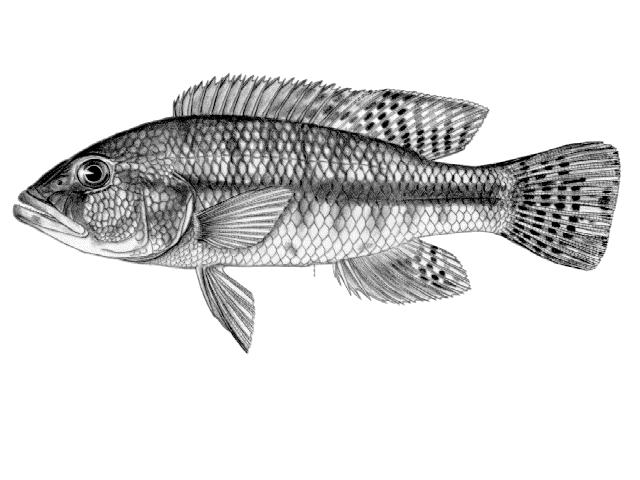| Cichlidae (Cichlids), subfamily: Pseudocrenilabrinae |
| 39.6 cm SL (male/unsexed); max.weight: 4,000.0 g |
|
demersal; freshwater, |
| Africa: Okavango, upper Zambezi, Kafue, Kasai and Zambian Congo systems (Ref. 11970, 13332, 94654, 97233, 97235, 128638), including upper Lualaba in Democratic Republic of the Congo (Ref. 97233) and Mweru-Bangweulu area of Upper Congo River basin (Ref. 95585, 97233); also Cunene River (Ref. 13332, 120641). It has been introduced to Lake Kariba and elsewhere in Zimbabwe (Ref. 94654, 128638), including Sabi River catchment (Ref. 13721), and to Shashi Dam in Botswana (Ref. 6465) and South Africa (Ref. 6465). |
|
Dorsal spines (total): 15-17; Dorsal soft rays (total): 14-16; Anal spines: 3-3; Anal soft rays: 10-12. Diagnosis: The presence of four or five scale rows between the posterior margin of the orbit and the ascending arm of the preoperculum, the presence of widely set unicuspid teeth on the jaws, widely separated gill rakers, and anal fins with egg ocelli places this species in Serranochromis (Ref. 128638). Breeding males of S. jallae possess ocelli that are restricted to the posterior 4-5 membranes of the anal fin, which delimits them from all other Serranochromis species, which have ocelli throughout the anal fin in breeding males, with the exception of S. robustus (Ref. 128638). Serranochromis robustus generally has a longer lower jaw than S. jallae, 50.7-59.6% of head length vs. 49.2-52.7%; it is not as deep-bodied as S. jallae as evidenced by the distance between the posterior insertion of the dorsal fin and the posterior insertion of the anal fin, 13.4-15.1% of standard length in S. robustus vs. 14.9-18.4% in S. jallae; additionally, S. robustus has a narrower least caudal peduncle depth than S. jallae, 10.9-12.8% of standard length vs. 11.3-14.2%, the least caudal peduncle depth of all S. robustus was less than 12.8% of standard length while for S. jallae, except for the smallest specimen, the least caudal peduncle depth was greater than 13.2%; Serranochromis robustus has a smaller horizontal eye diameter than S. jallae, 17.7-27.4% of head length vs. 18.6-25.5%; in general, S. robustus has more teeth in the outer row of the left lower jaw than S. jallae, 14-23 vs. 13-14 (Ref. 128638). Adults in breeding colour of Serranochromis robustus are blue/green laterally with a narrow yellow marginal band on the dorsal fin and usually a small yellowish tip to the upper caudal-fin lobe; adults in breeding colour of S. jallae are yellow/green laterally with a bright orange marginal band on the dorsal and caudal fins in fish from the Okavango River system, but creamy yellow bands in fish from the upper Zambezi River system; the throat and belly of S. jallae becomes more intensely yellow-orange in breeding dress hence the local name 'yellow-belly'; rarely, specimens from the Okavango River in Namibia also have yellow rather than orange marginal bands (Ref. 128638). Description: Head elongate, 35.8-39.7% of standard length; cheek depth 23.1-33.2% of head length; snout elongate, 33.9-38.6% of head length, and posterior end of lower jaw anterior to anterior margin of orbit; two to three pored scales posterior to hypural plate, and 7-9 rows of scales on cheek; lateral line scales 37-39 (Ref. 128638). Outer arch of epibranchial with 4 gill rakers; outer arch of ceratobranchial with 11-12 gill rakers (Ref. 128638). Teeth in 2 series on upper and lower jaws (Ref. 128638). Pectoral fin immediately posterior to posterior margin of opercle and directly under origin of dorsal fin; pelvic fin posterior to origin of dorsal fin; caudal fin rounded; dorsal fin with 15-17 spines and 14-16 rays, anal fin with 3 spines and 10-12 rays, pelvic fin with 5 rays, pectoral fin with 15-16 rays (Ref. 128638). |
| Juveniles occur mostly on the floodplain and in lagoons and secondary channels, but larger adults appear to prefer mainstream habitats, like deep main channels and permanent lagoons,and are associated with in-stream structures such as woody debris, macrophyte beds, reeds, and eroded clay cliffs on outside bends of the rivers (Ref. 7248, 94654, 128638). Large specimens patrol open water of rivers and lakes, never very far from shore (Ref. 246) and live in well-vegetated quiet waters or near submerged trees or rocks in the lee of the river’s main current, lunging out to capture prey (Ref. 5614). Predator on fish but also feeds on aquatic and terrestrial insects, shrimps and small crabs (Ref. 13337). Adults often feed on squeakers (Ref. 7248, 13337, 94654). Mouthbrooder (Ref. 246, 13337, 13721) and multiple spawner (Ref. 13337). Constructs shallow nest on sandy or muddy substrate in shallow water (Ref. 13337). Reported to have adverse impact on native fish species in Zimbabwe (Ref. 94654). |
|
Least Concern (LC); Date assessed: 01 May 2009 Ref. (130435)
|
| harmless |
Source and more info: www.fishbase.org. For personal, classroom, and other internal use only. Not for publication.
